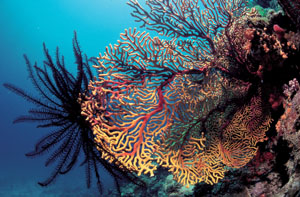A Kerama Kind of Day
Back to Contents of Issue: November 2003
|
|
|
|
by Michael E. Stanley |
|
|
It was the last day of October, well past the end of the summer tourist season. This little island, Zamami, is one of a clump of islands called the Keramas, off the west side of Okinawa. I didn't think too many Japanese -- let alone foreign residents -- would find their way out here in the fall.
Insistent words tumbled out of his mouth: "This has gotta be Japan's secret corner! It's paradise!" I looked up from the underwater camera housing I was attempting to repair.
"That's about right," was my response. "Now you've found it."
I was dramatically low-key so as to assume the role of senior-gaijin-off-the-beaten-track. I think it might have worked.
"I've been teaching English in Nagoya for three years," he said, "and I'm going back to the US in five days. Some friends mentioned this place, so I thought I'd have a look. Wow! This is a really different part of planet Japan!"
He gestured at the green hills and the other small islands across the channel. "The coral, the fish... totally, totally..." His voice trailed off.
I remembered feeling much the same in 1990, when I first ventured out to Zamami aboard the lumbering Zamami-maru. Over the intervening years, the island -- and the others around it that make up the political entity called Zamami-son (Zamami village) -- has become my retreat from the grey insanity of the city, and my testing ground for underwater photographic experiments.
Warm and mostly calm waters surround Zamami and its neighboring islands, studded with a magnificent array of coral reefs easily accessible to scuba divers and snorkelers. In the summer months, the islands' waters host manta rays and a large population of sea turtles; between January and early April, they are home to a population of humpback whales that has in recent years triggered a small boom in wintertime whale-watching tours.
Okinawa has a number of smaller islands off its flanks, but most have quietly slumbered on as their populations have aged and diminished. The traditional fishing and farming livelihoods have little to hold the younger islanders. But the Keramas -- Zamami in particular -- had the good fortune to become a scuba diving destination during the economic bubble of the late 80s.
In those years, it seemed almost de rigueur for Japan's trendy young white-collar types to get their scuba certification, a big clunky diver's watch and a semi-permanent tan.
Many found their way to Zamami for a three-day holiday diving safari that allowed for both visits to coral reefs and a timely return to the office, something just not possible with foreign destinations.
Apparently the impression that the islands made on the blond English teacher was not an uncommon one, and during the peak of the summer-vacation season, it has become a bit of a challenge to book a room or space on the ferry from Naha. But in the off-season, especially during the fall, Zamami is often amazingly empty.
Generations ago, these coral-girt bits of land were home to brigands and smugglers who lived at the very edge of the Japanese world. Now they are a peaceful alternative to the congestion and rush of workaday Nippon.
From the western side of Okinawa, their rumpled silhouettes are barely visible on the horizon -- a secret corner, beckoning. @
|
|
Note: The function "email this page" is currently not supported for this page.


 THE SUNBURNED GAIJIN APPROACHED from down the street, his long blond hair dancing in the gusts blowing across the bay. He wouldn't have captured my attention on the Shonan shoreline southwest of Tokyo, or on the surfing beaches of Chiba's Pacific coast. But here he stood out.
THE SUNBURNED GAIJIN APPROACHED from down the street, his long blond hair dancing in the gusts blowing across the bay. He wouldn't have captured my attention on the Shonan shoreline southwest of Tokyo, or on the surfing beaches of Chiba's Pacific coast. But here he stood out.



